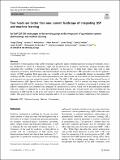| dc.contributor.author | Zhang, Tongli | |
| dc.contributor.author | Androulakis, Ioannis P. | |
| dc.contributor.author | Bonate, Peter | |
| dc.contributor.author | Cheng, Limei | |
| dc.contributor.author | Helikar, Tomáš | |
| dc.contributor.author | Parikh, Jaimit | |
| dc.contributor.author | Rackauckas, Christopher | |
| dc.contributor.author | Subramanian, Kalyanasundaram | |
| dc.contributor.author | Cho, Carolyn R. | |
| dc.date.accessioned | 2022-02-07T14:15:05Z | |
| dc.date.available | 2022-02-07T14:15:05Z | |
| dc.date.issued | 2022-02-01 | |
| dc.date.submitted | 2021-09-27 | |
| dc.identifier.issn | 1567-567X | |
| dc.identifier.issn | 1573-8744 | |
| dc.identifier.uri | https://hdl.handle.net/1721.1/139855 | |
| dc.description.abstract | Abstract
Quantitative systems pharmacology (QSP) modeling is applied to address essential questions in drug development, such as the mechanism of action of a therapeutic agent and the progression of disease. Meanwhile, machine learning (ML) approaches also contribute to answering these questions via the analysis of multi-layer ‘omics’ data such as gene expression, proteomics, metabolomics, and high-throughput imaging. Furthermore, ML approaches can also be applied to aspects of QSP modeling. Both approaches are powerful tools and there is considerable interest in integrating QSP modeling and ML. So far, a few successful implementations have been carried out from which we have learned about how each approach can overcome unique limitations of the other. The QSP + ML working group of the International Society of Pharmacometrics QSP Special Interest Group was convened in September, 2019 to identify and begin realizing new opportunities in QSP and ML integration. The working group, which comprises 21 members representing 18 academic and industry organizations, has identified four categories of current research activity which will be described herein together with case studies of applications to drug development decision making. The working group also concluded that the integration of QSP and ML is still in its early stages of moving from evaluating available technical tools to building case studies. This paper reports on this fast-moving field and serves as a foundation for future codification of best practices. | en_US |
| dc.publisher | Springer US | en_US |
| dc.relation.isversionof | https://doi.org/10.1007/s10928-022-09805-z | en_US |
| dc.rights | Creative Commons Attribution | en_US |
| dc.source | Springer US | en_US |
| dc.title | Two heads are better than one: current landscape of integrating QSP and machine learning | en_US |
| dc.type | Article | en_US |
| dc.identifier.citation | Zhang, T., Androulakis, I.P., Bonate, P. et al. Two heads are better than one: current landscape of integrating QSP and machine learning. J Pharmacokinet Pharmacodyn (2022) | en_US |
| dc.contributor.department | Massachusetts Institute of Technology. Department of Mathematics | |
| dc.relation.journal | Journal of Pharmacokinetics and Pharmacodynamics | en_US |
| dc.eprint.version | Final published version | en_US |
| dc.type.uri | http://purl.org/eprint/type/JournalArticle | en_US |
| eprint.status | http://purl.org/eprint/status/PeerReviewed | en_US |
| dc.date.updated | 2022-02-06T04:14:09Z | |
| dc.language.rfc3066 | en | |
| dc.rights.holder | The Author(s) | |
| dspace.embargo.terms | N | |
| dspace.date.submission | 2022-02-06T04:14:09Z | |
| mit.license | PUBLISHER_CC | |
| mit.metadata.status | Authority Work Needed | en_US |
